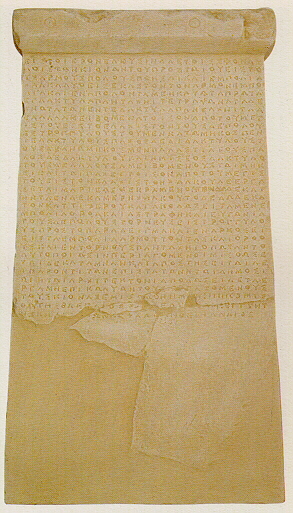
In the museum of Elefsis a stele of the 4th century BC is kept, discovered by D. Philios in 1894 and studied by the Professor of the University of Athens and for many years chairman of the Administrative Council of ELOT G. Varoufakis.
“ Its text refers to a decree concerning the manufacture of bronze fittings known as “empolia” and “poloi” to be used for the assembly of the column drums (as shown in this picture) and the erection of the Philonian Stoa, named after the architect Philon, a portico in front of the much older building, the Telestirion. The decree comprises strict technical specifications, and, therefore, constitutes one of the oldest European standards. It is worth noting the part of the decree concerning the chemical composition of bronze fittings: “…He (the contractor) will use copper from Marion, the alloy being made of twelve parts, eleven of copper to one of tin …” It should be noted that chemical composition is expressed on the basis of the Babylonian arithmetical system, since the number 12 is a sub-multiple of 60. Regarding the origin of the copper alloy, i.e. the bronze, the latter should be imported from Marion of Cyprus, a very important commercial and metallurgical centre at that remote time. Ostensibly the inspector was directed to apply an empirical procedure of quality control, in order to check whether the bronze composition was in conformity with the requirements of the said specifications. We must bear in mind that according to another inscription referring to the Anthemion of Goddess Athina at the Parthenon (420 B.C.), the price of copper was 35 drachmas per talent (a talent was equal to about 25 kg), while the price of tin was 230 drs per talent, i.e. over 6.5 times higher than that of copper. The supplier would therefore be tempted to cast a cheaper and consequently poorer in tin and thus more profitable copper- tin alloy, if he knew that no control existed. It was for this reason that the required quality was so precisely dictated and a system of quality control should have put in place. Had control been relaxed, the contractor stood to make an illegal profit. Based on the number of columns, the number of drums per column, the exact sizes given by the inscription and the density of the copper alloy to be used, I calculated that the total mass of the ordered alloy was 3300 kg. Had the contractor been allowed to cheat, he would have made an illegitimate profit of between 500 and more than 700 drachmas; sums very high for the time rendering quality control indispensable. ”
This study leads to the conclusion that the Elefsis stele is the oldest European Standard.
From the Book of Varoufakis George “Ancient Greek Standards- The History and Control of the Materials which left their Mark on Greek Civilisation” AEOLOS, Athens 1999, p. 54-61.